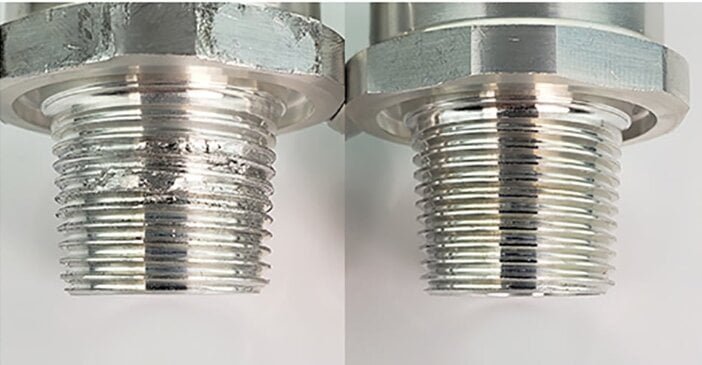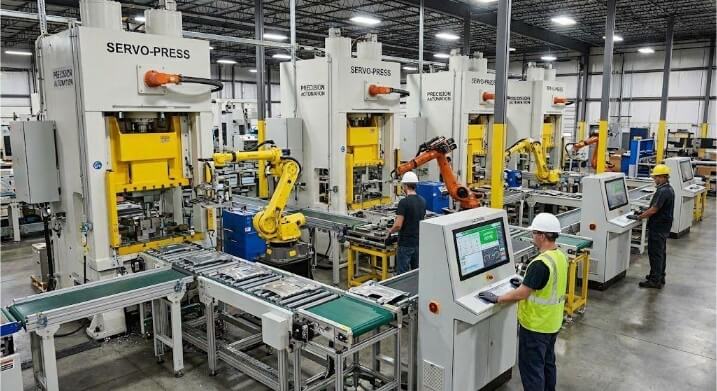Metal galling, a phenomenon not well known to those outside the sheet metal industry, plays a vital role in the longevity and functionality of metal components. My journey into the metal fabrication processes reveals that addressing potential pitfalls, such as wear and tear, is crucial.
Learn more about metal galling and its causes. Also, learn how to prevent it. Learn how to keep your metal parts functional and smooth for many years.
Metal Galling: The Basics
This section aims to explore wear and tear definitions and fundamentals.
What is metal galling?
Metal galling is when two metal surfaces, typically under load and in motion relative to one another, adhere to each other at points of contact. This unintended adhesion can tear the metal surface when the parts are separated or moved, which compromises the integrity and functionality of the components.
The Physics Behind Metal Galling – Friction and Adhesion
Friction and adhesion are the critical components of metal galling physics. Friction can cause heat, increasing the adhesion at the contact points. The mechanical interaction between surfaces that are under load also increases the likelihood of adhesions.
Types of Metals Prone to Galling
It is essential to know which metals are susceptible to annoying and their levels of susceptibility. This will ensure the durability and functionality of your metal parts.
Common metals and alloys
Some metals, such as stainless steel, aluminum and titanium, brass, and certain steel alloys, are more susceptible to galling. These metals’ tendency to gall depends on their physical properties, such as hardness or flexibility. Galling is more common in metals that are soft or can deform easily under pressure.
Compare Susceptibility
Stainless Steel
Stainless steel may gall, especially if you press the surfaces together. Galling can cause the metal to tear and seize, compromising an assembly’s integrity. You can lower the risk of galling by choosing the correct stainless steel grade and treating the surface or applying lubrication.
Aluminium
Aluminum is a relatively soft metal, which makes it susceptible to galling. Aluminum surfaces can easily adhere and deform when they come in contact with each other under load. This leads to wear and damage. Using alloys that harden the surface or adding protective coatings can protect aluminum from galling.
Titanium
Titanium can be welded to itself when under pressure. This tendency poses challenges for applications that involve sliding or rotating movements. To stop titanium components from galling, ensure they match well and have smooth surfaces, and apply lubricants.
Causes and Mechanisms
A variety of factors can impact metal galling. Each factor plays a role in either reducing or exacerbating this issue.
What is the influence of surface texture on metal galling?
Surface roughness plays a significant role in metal galling. Surfaces with a higher level of roughness tend to have more prominent peaks and valleys. These can adhere or interlock under pressure, causing galling. Smoother surfaces are less likely to interlock mechanically but can still experience irritation because of the increased contact area.
Material Composition: Its Impact
Galling-Prone Metals: Chemistry
The chemical composition influences the tendency of metals to gall. Metals that are more ductile or undergo strain-hardening will be more susceptible to galling. This is because the surfaces of these metals can deform when under pressure. This increases the surface area and likelihood of adhesion.
The Effects of Alloying Materials on Galling Resistance
Alloying can have a significant impact on a metal’s galling resistance. Molybdenum, for example, can improve the galling resistance of specific stainless steel grades by increasing their hardness and decreasing adhesion. The careful selection of alloying components in aluminum and titanium allows them to tailor their properties to make them less susceptible to galling.
Temperature, Humidity and Corrosive Environments
The operating environment has a significant impact on the annoying behavior of metals. High temperatures can accelerate galling by increasing the tendency for metals to adhere. Moisture can cause corrosion and affect surface roughness, leading to galling. Corrosive environments can exacerbate these effects, highlighting the need for corrosion-resistant materials and coatings.
Identification and Analysis of Galling
Identifying and analyzing galling in metal components early on is essential to maintain their functionality and integrity. Shengen can implement measures to prevent galling and guarantee the reliability of its products by understanding these aspects.
Early signs of Metal Galling
Visual Indicators & Surface Analysis
Initial signs of galling are often visible as damage or irregularities on metal surfaces. Scuff marks or areas of metal that appear to be torn, smeared, or scratched can be the first signs. Surface analysis using microscopes can reveal the microscopic welding of materials and the transfer of material characteristic of galling.
Diagnostic Tools and Techniques
The use of advanced diagnostic techniques and tools is essential to identifying galling. You can use SEM and EDX techniques to take images of the galled surface and analyze its composition. This provides insight into adhesion mechanisms and material transfer.
Metal Galling: The Consequences
Operational Failures & Economic Impacts
Galling can cause significant failures in operation, such as seizing moving components, increased friction, and premature wear. These failures can lead to downtime, higher maintenance costs, and replacement parts, all of which have significant economic implications. Costs associated with galling are high for businesses and industries that rely on machinery and equipment running smoothly, like the aerospace and automotive sectors.
Safety Concerns and Longevity Reduced
Safety is a concern for galling beyond its economic impact. Galling-induced failures can be dangerous in critical applications such as aerospace or medical devices. Galling also reduces the durability of metal components. This leads to a shorter lifespan and higher lifecycle costs.
Prevention Strategies
In the design and manufacturing of metal components, preventing galling is essential. We at Shengen take a holistic approach to preventing galling, including strategies such as material selection, treatment, thoughtful design, and lubrication and solution solutions.
Material Selection and Treatment
Galling Resistant Coatings and Materials
Preventing galling begins with choosing materials that are resistant to it. Some stainless steel alloys, for instance, are designed to resist galling. Nickel-based or chrome-based coatings can provide a protective barrier that reduces metal-to-metal contact and the risk of galling.
Heat Treatment for Surface Condition
Heat treatment can improve the resistance of metals to galling by altering their hardness and microstructure. Surface conditioning techniques such as polishing or creating specific textures can reduce the likelihood that metals will gall by minimizing metal-to-metal contacts and reducing surface roughness.
Design Considerations
Engineers for reduced Friction and Wear
The design is essential in preventing galling by minimizing friction and wearing. Designing components with lower contact pressures and optimizing the surface area can significantly reduce the risk of galling. By incorporating features like grooves or channels, you can reduce friction by distributing lubricants more efficiently.
The best way to pair metal surfaces
The combination of metal surfaces within a component may influence the likelihood of galling. Choosing metals that are less likely to stick together under operating conditions or using combinations of soft and hard materials can effectively manage the risk of galling. This pairing considers both materials’ properties to ensure compatibility and resilience under stress.
Lubrication Solutions
What are the different types of lubricants?
Lubricants are essential in galling prevention because they create a barrier between sliding metal surfaces. The application, temperature, and environmental conditions will determine the type of lubricant you choose, whether oil, grease, or solid lubricants such as graphite or Molybdenum Disulfide.
Applicability Techniques and Best Practices
Proper application techniques and best practices are crucial to ensure lubrication prevents galling effectively. It is essential to ensure even coverage, maintain adequate lubricant, and select application methods suited to the component’s design and operational use. Teams set up regular maintenance and inspection schedules to check how well the lubrication works and quickly fix any problems.

Remediation and repair
Shengen understands the importance of dealing with annoying damage quickly and efficiently to restore component functionality. This section examines the technologies and techniques that allow for successful galling repairs.
Mechanical Repair and Surface Regeneration
Mechanical repair methods such as grinding or machining can remove the galled material from a component and restore its surface integrity. It’s crucial to monitor these processes closely to prevent further damage. You can restore the component’s original appearance by polishing and applying a surface coat.
When and how to weld and fillet
When mechanical repair isn’t enough, they use welding and filling techniques. They fill the damaged area with material and finish the surface to blend seamlessly with the surrounding areas. The base metals and intended use of the component will determine the choice of filler and welding method. Skilled technicians are required to perform this procedure. They must also be able to control the repair area precisely so that it blends in seamlessly with the original metal and maintains its mechanical properties.
Conclusion
Our focus has been exploring the causes, effects, prevention strategies, and remediation methods of metal galling. Observing the pivotal role of material choice, surface treatment, and design optimization in reducing the risk of metal galling has enlightened us. We excel in educating customers and partners about abrasion remediation and prevention.
Do you need a reliable sheet metal parts manufacturer? Shengen is the place to go. We specialize in sheet metal laser cutting, bending, surface finish, and sheet metal welding. Reach out to Shengen Today and seek help from professionals!
FAQs:
What’s the difference between wear and galling?
Wear gradually thins components by removing material from surfaces. Sticking metal surfaces together can irritate, leading to material transfer and tearing. This often leads to parts sticking together.
Is a specific metal likely to gall before using it?
If you need more clarification, check the metal’s hardness and flexibility. Metals that are softer or more ductile will be more likely to gall. Assess the risk of galling by consulting experts or performing tests. Manufacturers can also provide information on galling resistance.
Does the industry have any standards for testing galling resistance?
Yes. ASTM G98, a standard test for galling resistance by controlled force, is available. It allows for comparing materials galling resistance to make informed choices about the material.
Can galling in engineering applications be eliminated?
By selecting resistant materials, optimizing the design to reduce friction, applying protective coatings, and using lubricants, it is possible to eliminate galling. Research is continually improving mitigation strategies for galling.
How frequently should components susceptible to galling be inspected or changed?
Inspection frequency depends on the application, usage conditions, and importance of the components. Regularly checking for signs of galling is recommended. Replace the component if you observe significant galling or to prevent failure. To manage galling effectively, follow a maintenance plan that includes preventive measures.
Hey, I'm Kevin Lee

For the past 10 years, I’ve been immersed in various forms of sheet metal fabrication, sharing cool insights here from my experiences across diverse workshops.
Get in touch

Kevin Lee
I have over ten years of professional experience in sheet metal fabrication, specializing in laser cutting, bending, welding, and surface treatment techniques. As the Technical Director at Shengen, I am committed to solving complex manufacturing challenges and driving innovation and quality in each project.




